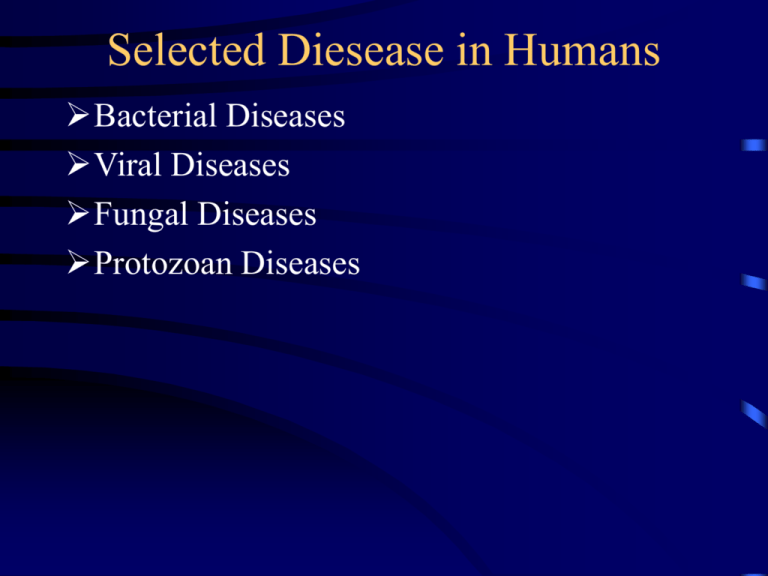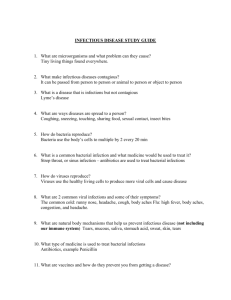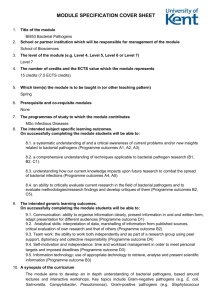Selected Diesease in Humans
advertisement

Selected Diesease in Humans Bacterial Diseases Viral Diseases Fungal Diseases Protozoan Diseases Bacterial Diseases Pathogenic bacteria typically enter through a specific portal of entry and begin as a localized infection; some bacteria have more than one portal Many bacterial pathogens can spread from the initial site to other areas of the body Many bacterial infections have been effectively treated with antibiotics; evolution of drug resistance in some strains have made them difficult to treat Several important pathogens are curtailed through the use of vaccines Bacterial Diseases Selected airborne bacterial pathogens Streptococcus pyogenes • Gram + cocci, Lancefield serological group “A”, catalase negative, beta hemolytic • Associated with streptococcal pharyngitis, scarlet fever (with erythrogenic toxin-producing strains), systemic infections, immune-related complications such as rheumatic fever and glomerulonephritis, and a skin infection called erysipelas Bacterial Diseases Selected airborne bacterial pathogens Neisseria meningitidis • Gram negative diplococcus; fastidious; cultured on chocolate agar • Highly contagious • Generally begins as an upper respiratory tract infection; may spread into bloodstream and then to the meninges • Symptoms of meningitis: “stiff neck,” headache, dizziness, disorientation, seizures, coma, death Bacterial Diseases Selected airborne bacterial pathogens Mycobacterium tuberculosis • Acid-fast rods, grows very slowly in culture • Detected by acid-fast stains of sputum, lung x-ray, culture • Tuberculin skin test determines if someone has been exposed to M. tuberculosis, but doesn’t necessarily mean the person has tuberculosis • Symptoms: Cough; destruction of lung tissue; tubercle formation in lungs; spread to other areas of the body with tissue damage Bacterial Diseases Selected airborne bacterial pathogens Legionella pneumophila • Gram negative aerobic rods; natural habitat is highly aerated aquatic environments such as streams • May contaminate bulding ventilation systems, water faucets, or other moist surface and is transmitted to humans who come into aerosols created from these sources • Symptoms: Mild to severe pneumonia (lung infection with fluid buildup in the lungs) Bacterial Diseases Selected foodborne bacterial pathogens Clostridium botulinum • Gram + anaerobic rods; forms spores; found in soil • Can contaminate raw or underprocessed foods; toxin forms in food before it is consumed, so it is a foodborne intoxication • Secretes botulinum toxin, a deadly neurotoxin that blocks nerve impulses at motor neuron end plate synapses and causes flaccid paralysis • Symptoms begin as soon as the toxin begins to be absorbed in the stomach • Death is due to respiratory and cardiac failure Bacterial Diseases Selected foodborne bacterial pathogens Staphylococcus aureus food poisoning • Gram + cocci; catalase and coagulase positive; common skin flora • Some strains of Staph. Aureus produce an enterotoxin that can be secreted in contaminated food; toxin forms in food before it is consumed, so it is a foodborne intoxication • The toxin causes mild to moderate cramping and diarrhea; symptoms appear a few hours after consuming the food and usually last only a few hours Bacterial Diseases Selected foodborne bacterial pathogens Salmonella species • Gram negative rods; facultatively anaerobic; a member of Enterobacteriaceae • Transmitted in contaminated foods, especially meat, poultry, & dairy products • A foodborne infection: Bacteria must colonize the intestinal tract to cause symptoms • Cramping, nausea, diarrhea • Salmonella typhi causes typhoid fever: intestinal ulceration, invasiveness, rose-colored rash on abdomen, less diarrhea but very high fever Bacterial Diseases Selected foodborne bacterial pathogens Helicobacter pylori • Gram negative microaerophilic spirillum • Groes underneath the mucous layer in the stomach • A major cause of stomach ulcers Bacterial Diseases Selected soilborne bacterial pathogens Bacillus anthracis • Gram + facultatively anaerobic rods; forms spores • Found in contaminated soil or animals (livestock) • May either be transmitted through skin contact (cutaneous anthrax), oral ingestion (intestinal anthrax), or inhalation (pulmonary anthrax) • Lesions & tissue destruction occur at the affected sites • Pulmonary anthrax has close to a 100% fatality rate Bacterial Diseases Selected soilborne bacterial pathogens Clostridium tetani • Gram + anaerobic rods; forms spores; found in soil • May grow in contaminated wounds or cuts, where it produces the toxin tetanospasmin; a neurotoxin that acts as a cholinesterase inhibitor; mainly effects the central nervous system • Nerve synapses remain closed because cholinesterase fails to break down the neurotransmitter acetylcholine; this causes rigid paralysis Bacterial Diseases Selected arthropodborne bacterial pathogens Borrelia burgdorferi • Gram negative spirochaete; causative agent of Lyme disease • Transmitted through the bite of an infected deer tick (Ixodes) • Initial symptoms include fever, congestion, lymph node swelling, “flu-like” symptoms and the developemnt of a large, spreading rash (erythyma chronicum migrans) at the site of the tick bite • If untreated, inflammation & damage to joints, arthitis-like symptoms, and damage to the cardiovasular system can result Bacterial Diseases Selected arthropodborne bacterial pathogens Rickettsia rickettsiae • Gram negative rickettsia; a small, irregularly-shaped bacterium that is an obligately intracellular parasite • Causative agent of Rocky Mountain Spotted Fever • Transmitted through tick bites • Symptoms include high fever, a rash that begins as pinpoint spots at the extremities and spreads to the trunk of the body (macropapipular rash), seizures and coma Bacterial Diseases Selected arthropodborne bacterial pathogens Rickettsia prowasekii • Gram negative rickettsia; a small, irregularly-shaped bacterium that is an obligately intracellular parasite • Causative agent of epidemic typhus • Transmitted through human lice; predominately spread via body lice, not head lice or crab lice • Symptoms include high fever, a rash that begins as pinpoint spots on the trunk of the body and spreads to the extremities (macropapipular rash), seizures and coma; has a very high fatality rate • Easily spread under conditions of reduced sanitation where lice are likely to spread Bacterial Diseases Selected bacterial STDs Treponema pallidum • Gram negative spirochaete; transmitted via sexual contact or congenitally • Initial symptom (primary syphilis) is usually the appearance of a crusted, purple, painless lesion called a hard chancre at the site of infection; lesion usually disappears on its own after a few weeks but the infection remains in the blood • Later symptoms include fever, rash, & flu-like symptoms (secondary syphilis) and the formation of lesions called gummae throughout the body (tertiary syphilis), with neurological, cardiovascular, & other damage. Bacterial Diseases Selected bacterial STDs Neisseria gonorrhoeae • Gram negative diplococcus; fastidious; cultured on chocolate agar • Transmitted via sexual contact or congenitally • Urinary tract symptoms: Urethritis with painful urination & pus discharge; cystitis; kidney infection • Male reproductive symptoms: Prostatitis; epididymitis • Female reproductive symptoms: Infections of the vagina, cervix, uterus, Fallopian tubes; pelvic inflammatory disease • Eye infections (trachoma) Bacterial Diseases Selected miscellaneous bacterial infections Pseudomonas aeruginosa • Gram negative aerobic rod; commonly found in soil or aquatic environments • Can contaminate aerated moist surfaces such as faucets, respiratory equipment, etc. • A common cause of hospital-acquired (nosocomial) infections • Respiratory tract infections, urinary tract infections, and severe infections in burn patients Bacterial Diseases Selected miscellaneous bacterial infections Staphylococcus aureus infections • Gram + cocci; catalase and coagulase positive; common skin flora • Infections associated with Staph. aureus include pimples, boils, abscesses, carbuncles, septicemia, scalded skin syndrome in infants, toxic shock syndrome Viral Diseases Viruses are classified based on nucleic acid structure (DNA or RNA; single- or double-stranded; segmented or nonsegmented) capsid structure (helical, icosahedral, or complex) envelope structure (enveloped or nonenveloped) host (animal, plant, or bacteria) mechanism of replication site of infection (pneumotrophic, dermatotrophic, viscerotrophic, neurotrophic) Viral Diseases Influenza Member of Orthomyxovirus family Segmented (8 segments), single-stranded, negative-sense RNA that encode 11 proteins RNA is packaged into helical nucleocapsids and surrounded by an envelope Two envelope proteins: hemagluttinin (H) and neuraminidase (N) Three major types: Influenza A, Influenza B, & Influenza C; of which Influenza A strains are the most virulent in humans Viral Diseases Influenza Influenza can be transmitted via human-human airborne contact, or from contact with contaminated birds, swine, or other animals Symptoms • in mild cases include fever, lymph node swelling, congestion, fatigue, primary & secondary pneumonia • Highly virulent strains may exhibit hemorrhaging from nose & mouth, ears, eyes, intestine, internal organs • Other complications include Guillian-Barre & Reyes syndrome Antigenic variation and genetic recombination in the H & N proteins can lead to new strains of influenza Each year epidemiologists determine the best “combination” vaccine for the year’s prevalent strains Viral Diseases Influenza Some important pandemics of influenza • H1N1: 1918-1920 “Spanish flu;” estimates of deaths worldwide range from 30 - 100 million people • H2N2: 1957-1958 “Asian flu” with 1 - 1.5 million deaths • H3N1: 1968-1969 “Hong Kong flu” with about 1 million deaths • H5N1: Current “avian flu” threat – Genotype first observed in 1959, but evolved into the current highly pathological strain that was discovered in 2004 – No human to human transmission seen yet; cases have been bird to human contact – If human to human transmission were to evolve in this strain, experts have estimated that perhaps 5 - 150 million people could die worldwide Fungal Diseases Properties of Fungi Eukaryotic Fungal cell walls with cellulose & usually with chitin Heterotrophic metabolisms Many are saprophytes; a few species are parasitic Morphology: single cells (yeasts) or filaments (hyphae) Most species have both sexual & asexual mechanisms of reproduction Fungal Diseases Candida albicans Grows as a yeast or sometimes as short hyphae (pseudohyphae) Common normal flora in the mouth, intestine, & vaginal tract Competiton with bacterial flora helps keep Candida in check; conditions that reduce bacterial flora (e.g. antibiotic use) or weaken immune system (e.g. AIDS) can cause candidiasis infection to develop Symptoms include oral candidiasis (thrush), intestinal candidiasis, and vaginal candidiasis Fungal Diseases Dermatophytic fungal infections Infections of the hair, skin, nails Several genera of dernmatophytic fungi: Microsporum, Epidermophyton, Trichophyton Symptoms: Scaly, red or raised rash on skin (“ringworm”), discolored and splitting nails, hair loss Often described by the term “tinea” with the name of the area infected: tinea corporis (ringworm of the body); tinea pedis (“athlete’s foot”); tinea unguium (ringworm of the nails); tinea cruris (“jock itch”); tinea barbae (ringworm of the beard) Protozoan Diseases Properties of Protozoa A heterogeneous group of eukaryotic microbes Generally characterized by lack of a cell wall and a heterotrophic metabolism (although one group, Euglena, is photosynthetic Most are free-living; a few are parasitic Classical classification based on mechanism of motility; rRNA data has shown the existance of more phyla than previously suspected Motile by pseudopodia, flagella, cilia, or nonmotile Most reproduce asexually; a few groups have complex sexual & asexual cycles Protozoan Diseases Giardia lamblia A flagellated parasite of humans and other mammals Actively growing and reproducing form(trophozoite) grows in the intestinal tract of the host In the intestine, trophozoites develop into cysts that are shed in the feces; the disease is transmitted when the next host ingests contaminated food or water and the cysts break open and develop into new trophozoites in the intestine Symptoms: Profuse, foul-smelling diarrhea; dehydration; chronic recurrences Often misdiagnosed; diagnosis requires microscopic or serological ID of trophozoites & cysts in stool or intestinal contents Protozoan Diseases Toxoplasma gondii Member of the phylum Apicomplexa, a group characterized as parasites with complex lifestyles having both sexual and asexual stages The sexual stage develops only in members of the cat family, with sexual cysts (oocysts) shed in the feces Oocysts are ingested by other animals (e.g. mice, cattle), where they travel to the muscle tissue & develop into asexual cysts (tissue cysts) Cats acquire the parasite by ingesting the infected meat of prey such as mice Humans acquire the parasite via the oral route, through contact with cat feces or ingestion of contaminated meat (often beef) Protozoan Diseases Toxoplasma gondii (cont) Infections in humans are often asymptomatic, except when the person is immunocommpromised, in which case encephalitis may develop Pregnant women are at risk because the parasite can cross the placental barrier & infect the baby, with the possibility of birth defects or miscarriage The parasite is very prevalent in humans, with estimates of 65% of people worldwide and 33% of people in the US over 12 Studies in mice suggest the parasite may actually alter its host’s behavior; e.g., mice exhibit riskier behavior such as less fear of cats. Some studies have suggested effects of the parasite on human behavior as well.








